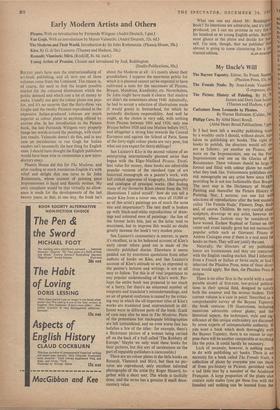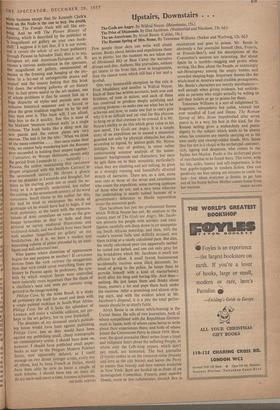My Uncle's Will tl -
The Bayeux Tapestry. Editor, Sir Frank Stentoo ti
(Phaidon Press, 47s. od it The Female Nude.- By Jean-Louis Vaudcyer• ti (Longmans, 4551 n
The Picture History of Painting. By H. NN (Abbe Henri Breuil Publications, 5 gns.) IF I had been left a wealthy publishing house by a wealthy uncle I should, without doubt, hale
taken to publishing art books. The right ail 1 books to publish, the directors would tell nie,
are as follows : yet another on Picasso, oW more on the Impressionists, one on the Post' Impressionists and one on the Glories of 0
Renaissance. These volumes should be large in format and filled with colour plates no matter what they look like. Venturesome publishers rn:4 risk monographs on any artist born since 1870 providing 'he is not less fashionable than Braque' The next step is the Dictionary of Modern Painting and thereafter the Picture History Of Painting. Nor, I surmise, can one fail with selections of reproductions after the best masters, called The Female Nude,' Flowers, Dogs, Birds and, of course, Children. Be very careful about sculpture, drawings or any artist, however env portant, whose fashion may be considered to have waned. Eschew Raphael or Turner on this count and avoid equally great but not necessarily popular artists such as Giovanni Pisano or Andrea Castagno even if there is a real need for books on them. They will not justify the cost.
Naturally, the directors of my publishing ,house are businessmen and they are concerned with the English reading market. Had I inherited from a French or Italian or Swiss uncle, or had I inherited the Phaidon Press, none of these d rec- tives would apply. But then, the Phaidon Press is unique.
There is no other firm in the world with a com- parable record of first-rate, low-priced publica- tions in their special field, designed to satisfy both the amateur and the serious student. This current volume is a case in point. Described as a comprehensive survey of the Bayeux Tapestry the book contains 150 illustrations, including numerous admirable colour plates; and the historical aspects, the techniques, style and sig- nificance of this unique embroidery are discussed by seven experts of unimpeachable authority. If you want a book which deals thoroughly with the Bayeux Tapestry, there is no reason to sup- pose there wilt be another comparable at anything like the price. It could hardly be necessary.
Lack of necessity, however, is nothing much to do with publishing art books. There is no necessity for a book called The Female Nude, a collection of plates by everyone you can think of from pre-history to Picasso, garnished with a sad little text by a member of the Academie Frangaise. A large proportion of the plates also contain male nudes (you get these free with the females) and nothing can be learned from the Whole business except that Sir Kenneth Clark's book on the Nude is the one to buy. No doubt, however, The Female Nude will sell like any- thin. 8. And so will The Picture History of fatoting, which is described by the publisher as a magnificent art gallery on your own book- shelf.' I suppose it is just that, if it is not worse, and it covers the whole of art from prehistory through Picasso to Salvador Dali; that is to say, European art and American-European art. It Creates a curious ambivalence in the spectator, this magnificent art gallery, compounded of nausea at the framing and hanging of the pic- tures 'in a lay-out of unforgettable drama and impact' and the uneasy feeling that this brisk trot down the' echoing galleries of art history may in fact prove useful to the art student, one of whose problems is that he cannot link up a huge disparity of styles and periods into any cohesive historical sequence and is forced to piece the great tradition together bit by bit and take time over it. This book will, I am afraid, help him to do it quickly. For this is most of the Malraux 'museum without walls' in a single volume. The book looks like a shiny new jig- saw puzzle and the colour plates are very uneven. The text is for the tots: 'When we think of the many countries . . . that came under their rule, we cannot help wondering how the Romans ever succeeded in holding their empire together.' Caricature, by Werner Hofmann, covers only the period from Leonardo to . . . naturally . . . Picasso, the author maintaining that caricatura proper originated with the brothers Carracci in the seventeenth century. He throws a glance over his shoulder at Leonardo and Breughel, but takes as his starting point not so much the ac- tivity as it is generally understood, but rather the coining, in the seventeenth century, of the word caricatura. Small blame to the author for this, for had he tried to encompass the whole of grotesque art he would have had to begin, if not with prehistory, at the latest with the represen- tations of Attic comedians on vases or the gro- tesque terracottas so dear to Sulla and then proceed to survey medkeval illustrations and sculptural details, and we should have been faced with another 'magnificent art gallery' on our bookshelves. As it is, we have a modest and interesting volume of plates preceded by an intel- ligent and well-informed text. Who knows where distortion of appearances begins for one purpose or another? If caricature derives from the verb caricare (to exaggerate), then that verb could cover everything from pre- history to Picasso again. In prehistory, the sym- bols by which magical forces were controlled were naturally more important than the shape of a chieftain's nose and were per caricare exag- gerated in the image making. Philipp Cave, by the Abbe Breuil, is a study of prehistory (by itself for once) and deals with a single painted rockface in South-West Africa. Philipp Cave, for all it lacks the splendour of Lascaux, will make a valuable addition, not per- haps to the art gallery, but to your bookshelf. The directors of my deceased uncle's publish- ing house would have been against publishing Philipp Cave, just as they would have been against my publishing small, cheap monographs on contemporary artists. I should have done so, however. I should have published small paper- backs as near to the Penguin Modern Painters Series, now apparently defunct, as I could manage on two dozen younger artists, every one of whom, had he been French or Italian, would have been able by now to boast a couple of such tributes. I should have lost on them all. As my uncle said many a time, business is business.
MICHAEL AYRTON



































 Previous page
Previous page